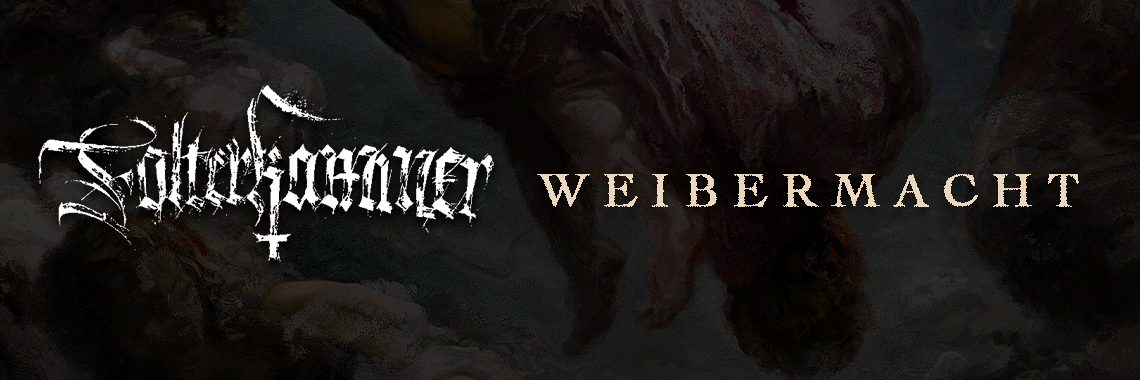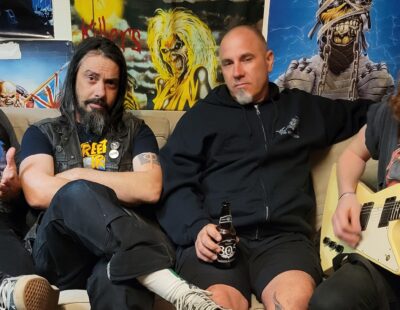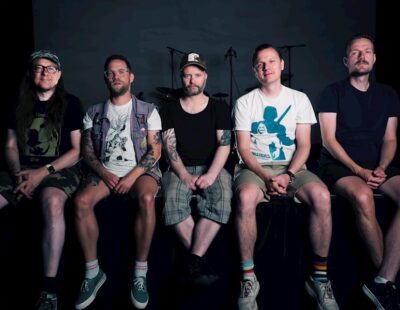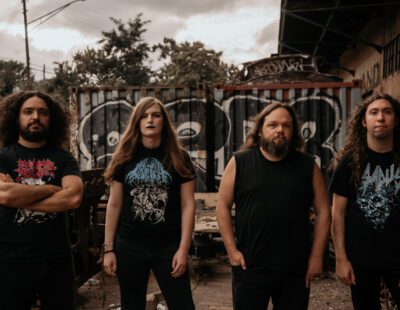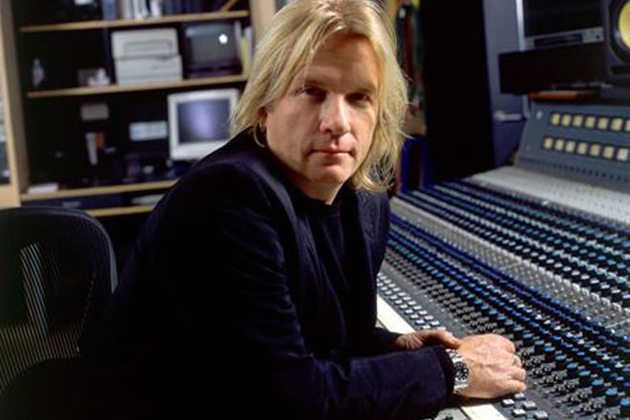
Producer, engineer, and musician Bob Rock (aka Robert Jens Rock) has a storied history. Whether you’ve formed your own opinions (likely) or constructed them after observing his role as producer, mentor, and friend to the likes of Metallica, Mötley Crüe, The Cult, Blue Murder, Skid Row, and more. Or, you watched in bemusement as the minutes rolled excruciatingly on in Metallica documentary, “Some Kind of Monster”. However you slice Rock’s involvement in heavy metal–equally important (every fucking second of Metallica’s self-titled and tenuous (“St. Anger”‘s snare drum sound [defended HERE])–he’s played a pivotal role. Metallica may not be stratospheric if it weren’t for Rock. Metallica may not have ushered in commercial viability to a largely maligned art. Metallica may not have entered their rock phase (Load and Reload), giving room to others, like Pantera, Alice in Chains, and System of a Down, to break sonic and commercial boundaries. Either way, Rock’s been influential.
Decibel had the rare chance to discuss gear, music, audio software, and, yes, Metallica with Rock. Normally, these types of conversations are stilted, clearly with one end of the conversation dominating. But with Rock, he engaged, he regaled and he asked questions. He was curious about things from his estate in Maui. Within 10 minutes, it was as if Decibel were speaking to not Rock but our buds at Relapse Records or Translation Loss Records or Nuclear Blast Records. While most of metaldom will blame Rock for destroying Metallica (in the mid-aughts, a petition was created to ‘Save Metallica’ from Bob Rock). Metaldom can be thankful Rock was key in the sonic evolution of the thrash riff. ‘Enter Sandman’, ‘Sad But True’, ‘The God that Failed’, and ‘My Friend of Misery’ retain the energy of vintage Metallica (OK, kill me now) but are moored in groove, in economy, and in feel.
Read on, folks. Bob Rock has arrived at Decibel.
Tell me about Bob Rock, the musician.
Bob Rock: I was born in ’54. So, I became of musical age in the ’60s. I grew up with The Beatles. Actually, I saw The Beatles get off the plane in Winnipeg. They went to Winnipeg and then to New York. My mom took me down. They got off the plane and waved to us. Growing up in Winnipeg, it was really The Beatles, The Stones, and The Dave Clark Five. But around ’68 or ’69, we moved to Victoria, and there was no hockey. I was in love with the guitar. I was by myself. I had no friends. My life became records and music. Then, Led Zeppelin came. English hard rock. That started it all, I think. For me, it was always about how records sounded. Even back then. I remember the first time I heard ‘Honky Tonk Woman’. I was hitchhiking and when I got in the car, it started to play. There was something about the sound of it. Same with ‘All Right Now’ by Free. Even ‘Good Vibrations’ sounded good back then. I wasn’t sure what was going on, but I wanted to do it. So, when I finished school, I went England with my partner, a friend of mine (Paul Hyde) who was English. We went over to be rock stars. It didn’t really turn out. At 18, I traveled through Europe, but we really went over there to play. Eventually, we went back home and started working labor jobs. We ended up in Vancouver at the beginning of the punk scene. I got a job at a studio called Little Mountain in ’76. When punk broke, I was learning how to make records. Since I already knew how to make a record, me and Paul recorded two songs together. We printed 1,000 copies and got a record deal with A&M Records. Or, IRS Records in the states. This was the start of the Payola$. Throughout the years, I was usually doing both, music and recording. I eventually got a job recording Prism, a Canadian rock band. I went on to do Loverboy. Then, Honeymoon Suite. Bon Jovi and Aerosmith came a little bit thereafter. With the Payola$, we made a little dent with ‘Eyes of a Stranger’ in Canada and in the states. The Payola$ went on to do a few more records, but my manager at the time, Bruce Allen, said to me, “You should concentrate on this [producing].” The Payola$ were kind of falling apart at the time, so focused I on producing. I did Kingdom Come, and that’s when things started to pick up. But to me, this job is all encompassing. It’s producing, it’s playing guitar, and it’s engineering, just making records. I love making records. It’s what I love to do.
At what point did you say, “I want to be a producer”? There’s a big lifestyle difference between a producer and a touring band.
Bob Rock: There is. Actually, when I did Slippery When Wet, I was promised a point due to all the work I did with [Bruce] Fairbairn. When Jovi became big, he [Fairbairn] reneged on the point. Then, when I did Permanent Vacation after that, he paid me less than what I got for Slippery. At that point, I thought to myself, “I’m out. I can do this by myself.” When we did all those records—as an assistant engineer, I was involved with Bay City Rollers, Dionne Warwick, Bryan Adams, basically everybody who rolled through Vancouver stopped at Little Mountain—I was thinking to myself, “This is going nowhere. I’m not getting to do bigger and better things.” So, the boot from Little Mountain was the greatest thing that happened to me. It made me who I am today. I’m lucky the stuff I did people liked. I’m still working to this very day because of it. I’m a lucky guy. [Laughs]
For the uneducated, describe a point and what it means.
Bob Rock: Well, if you take 100 percent of the sale of the record, one point would be one percent. Usually record deals were like: 20 points for the band, the producer got three or four points, and it goes from there. I know my American counterparts were making $20-$30,000 per record. I was making $10,000 Canadian, which is like $8,000 American for my work on Slippery. I hate to put it in those terms ’cause I’m a great believer in things happening for a reason. Even though I never held it against him [Fairbairn], I was pretty pissed at the time. I ended up doing New Jersey with Jovi so I got paid properly. It all kind of worked out. That was the last album I engineered for someone else.
For people outside the industry, what’s the difference between an engineer and a producer?
Bob Rock: Especially nowadays, it’s quite different. Back then, the engineers took care of recording the sonics, the technical part of recording. That’s what I did. The producer, at that point, was the overseer, the direction guy, the guy who worked with the artist. As an engineer, I translated what the band and Fairbairn wanted to hear. That was the sonics. When I made the transition to producer I realized I was bringing in more than the sonics. I was a musician, too. I was constantly working at it. I knew how to do it [the act of recording], but I really wanted to know how to do without interpreting somebody’s idea. I wanted my own fingerprint. I don’t think I was the producer I turned out to be. Mike Fraser was my assistant throughout my years as an engineer. I eventually realized I couldn’t do both as I became a producer. That’s when I’d get Mike Fraser to help me. In the ’80s, there was a certain sound that I got that people liked. I continued to develop that. That was part of my production. To be quite honest, each artist had a set of personalities. I had to deal with that. As an engineer, I could always be the nice guy, the guy who could hang. As a producer, you have to consider budgets, time, dealing with the personalities, and the songwriting. There’s another aspect to making music, especially with artists’ personalities.
A producer’s role seems to have changed. At least, where the producer is the focal point of power in the studio.
Bob Rock: Well, sure. In the ’70s, it was about the producer. The producer would say, “These are the drums you’re going to play.” I discovered as a musician the result wasn’t what the band sounded like. So, I formed my own opinions of what a producer should do. To me, I want to bring out the best in the band. That’s why “Sonic Temple” doesn’t sound like the “Black” album. Or, “Dr. Feelgood” doesn’t sound like “Blue Murder”. I will add character, but I need to serve the sound and the band. Basically, 80% of the album is the artist or the band. I’m there to help them achieve what they want.
What records did you feel were exemplary sonically? Jimmy Page and Eddie Kramer did some amazing things with Led Zeppelin.
Bob Rock: Ever since I started making money, even when I wasn’t making very much money, I was into sound. I collect sound. I’m a complete gearhead. Those things were always on my mind. The drums were always based on [John] Bonham’s. Then, there was the other side of it. What Ken Scott did with Supertramp and [David] Bowie. The guys who taught me were English. So, I learned to record with those ‘70s kind of sounds. I can do those in my sleep. But when I went to Vancouver, I only had a certain set of tools. So, when I’d hear a record, I’d go, “I want do that!” I was constantly emulating. There was a lot of discovery back then. Today, everything’s pre-programmed, but back then if you wanted Ken’s sound and you weren’t with Ken, you had to try everything to emulate. When SSL’s (Solid State Logic) came out, at Little Mountain we were like, “How are they doing that?!” We had read about SSLs, right? I didn’t even use bus compression when I mixed Loverboy. I used to mix manually. The compression was done in mastering. How archaic is that? [Laughs] I was competing with a lot of guys who had access to and were using compressors. At Little Mountain, we didn’t have a whole lot.
How does your gear now differ from a professional standpoint? A lot of bands now are looking to use vintage gear and they go to great lengths to record on it.
Bob Rock: Oh, yeah! When I started, we had a 16-track Scully tape machine and Neve console. We had 1081s as well. I grew up on 1081s. When we got a 24-track, things were exploding. You have to realize, gear and audio technology grew in parallel to how albums were recorded. We had 16s, then 24s, then we synched two 24s, and then automation came in with the compression in SSL consoles. That all dictated how sonics developed and how we developed making records. We could get sounds out of SSL that we could never get out of a Neve. On a SSL, we could gate, compress, and signal change. The SSL was very well thought out by engineers. It’s an engineer’s dream, the SSL. All through the years I recorded on tape, the minute we played back the tape, we were EQ-ing what we had just recorded. A lot of people, unless they worked in tape, didn’t know that. We lost a lot of transience, top end, and punch. The tape would fade away. We always had to add a lot of top. There are a lot of drawbacks to tape. When digital came in, we started getting into samples. We’d trigger samples from the AMS (Advanced Music Systems) delay. We could de-tune. That’s how I could push the bottom on Feelgood. It was around the time I want from engineer to producer that the technology became available. Now, I could enhance drums. Then, it got into fully digital. When I did the “Black” album, we cut all the drums to tape and then did all the edits. To keep the tapes we edited, we got a 24-track Sony machine. So, that was the first digital machine that sounded good. The Sony really changed things. It was good. It sounded good. Then, Pro Tools came along. It didn’t sound good in the beginning but eventually Pro Tools sounded great. That was a major change. It was suddenly less tape. Quickly, it was no tape. Personally, I love digital. the transients are maintained. I don’t have to EQ as much. The whole argument to analog and digital. There’s a sound to analog. To me, it’s a plug-in now, a UA (Universal Audio) plug-in. I don’t have to fight it. I make warm records now. My records are big and fat. And digital.
What are some of your go-to plug-ins? I gather you’re into UA’s product.
Bob Rock: Ninety percent of what I use is UA, yes. I can tell you that my list of plug-ins is basically a list of what we just discussed. It’s funny, I got an original EMT 250 and when the plug-in came out, I wanted to throw it across the room. The EMT 250 UA plug-in has no-hiss, it doesn’t break down. The EMT 140 is beautiful. Same with the BX 20, which is hard to find. Never found a great one, now I have a great one in the UA plug-in. For the EQ, I can have 90 1081s. I’m a lucky guy. [Laughs] I have some original Tridents, the Ken Scott stuff. I use the Trident UA plug-ins on everything. Same with the Eventide harmonizer, the 910s. Now, I have one that doesn’t crackle or buzz or distort. It’s got all the qualities of the 910, but it’s clean. I’m a huge fan of UA.
But isn’t the crackle, buzz, and other artifacts what makes a record, well, a record. Made by humans kind of deal? The personality of the record.
Bob Rock: I get the character stuff. But I’m not talking about the character part of those things. I’m talking with the 250, a transistor would go and it’d sound like, “Kkkssshhhh!!!” I can’t use “Kkkssshhhh!!!” [Laughs] The Eventide harmonizer would go, “Uhauhauha!!!” Nobody wants that. [Laughs] That’s what I’m talking about. I’m all for the original harmonizers, the 12-bit ones. There’s a sound to them. I use them now. Same with the 224S. Everything I use is because of the sound. If it doesn’t sound good, it doesn’t work for me. I was skeptical of the new plug-ins, but now I’m using them all the time. I wouldn’t use the plug-ins if they didn’t sound good.
OK, so I’m sure you’ve been waiting for me to ask you a Metallica question, right? Is there a story, even an untold one, from the “Black” album that you could share? Studio stuff, I’m talking about.
Bob Rock: A lot of things have been said about the “Black” album. OK, when we started to mix I used the bus compressor on the SSL. That’s how I got it aggressive. So, I had the first mix in shape and James came in. He said, “I don’t want any compression on my guitars.” I said, “Well, this is what I do.” He just said, “Nope.” I had to solve the problem. I wasn’t sure what I was going to do. Luckily, I was at Hansen’s and they had a 6K console, which has three busses, A, B, and C. They go to the main bus. SSL had just released the compressor in a rack unit. So, I figured out I’d use that on the A bus, James’ guitars on the B bus, and everything else on the C bus. That was how I ended up working the record. Otherwise, if I couldn’t solve the problem, I wasn’t going to be doing the record. It was a complete workaround. That’s why the guitars are crushing without compression. That’s just the guitars. They’re in-your-face crushing. The drum compression doesn’t affect James’ guitars. I had a similar story with Tommy on “Dr. Feelgood”. He had his monitors live on stage. When we went into the studio, he said, “I need some bottom on the headphones.” So, I got some monitors and put them behind his kit. People were like, “Bob, you can’t do that.” I said, “Well, that’s what he wants.” So, I put these huge subbies behind the kit, and I put a little bit of the sub in the kit. He felt good, played amazing, and the sub ended up filling the room. Now, that’s insane. Most engineers won’t do that. But I was just doing a workaround once again for the artist. To make them comfortable.
Alright, the “Black” album is not like the others in your repertoire. What was it about Metallica that interested you? Certainly, they come from a different place than most bands you had produced up to that point.
Bob Rock: OK, I had bought Justice. The Cult were warming up for the Justice after Sonic Temple. When the tour hit Vancouver, I went to see Ian [Astbury] and Billy [Duffy]. I stayed to watch Metallica. I had heard the Justice record, but they sound heavy and big and monstrous and thick live. On record, there’s none of that weight. That was my thought. Months later, I hear they want me to mix their new album. I said, “I don’t want to mix your album, but I’ll produce it.” Somebody told me they were put off by that. Evidently, not. A little bit later, they came up to Vancouver to play me their songs. On cassette, right? I heard “Sad But True.” In my mind, I said to myself, “I can do this! I know how to make this sound big!” I knew how to make their weight work for them. I mean, Flemming [Rasmussen] had a way of recording the band. That’s pretty much what they knew. He did a fantastic job and it worked well. But they said to me, “If you produce this, you gotta do what you do.” So, I said to them, “I want you to play in the same room at the same time.” They had never done that before. Basically, there was no preconceived way of doing Metallica. I brought what I knew to the table and did what they told me to do. It was quite a change. These guys, they were deeper. More intense. There were times when I was thinking about James’ lyrics. I was thinking, “This guy’s as good as anybody.” He’s intense. He’s deep. I didn’t grow up on Metallica. I just came in to help them with a record. If were doing Led Zeppelin, that’d be a different story for me. I’d be so enamored with them, I’m not sure I could do it. With Metallica, they were just guys to me. I didn’t cater to what they were. I catered to what they wanted to do. That’s ultimately what a producer is.
The “Black” album is like 26 years old this year. What’s it like knowing you played a major role in that record. From a sales perspective it’s not far behind “Hotel California” or “Led Zeppelin IV”.
Bob Rock: I’m very proud of it. It’s a huge part of my life. I spent 15 years with those guys. I couldn’t have worked with a better band. It was difficult, but when you’re in a place that’s not comfortable you do your best work. Clearly, it’s some of my best work. It was all of us that made that record. No compromise. Culturally, in the music business that’s when Metallica got on the radio. It was the biggest cultural record I made. It changed what went on the radio. I’m very proud of that. I look back on it fondly. I continue to be impressed with artists I’ve worked with since. Like [Michael] Bublé and Van Morrison. But I will say the “Black” album is the one where it all came together.

